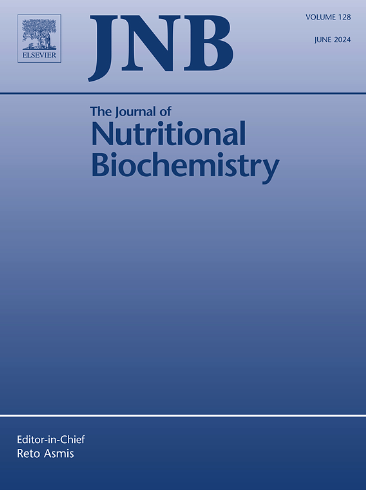Oleanolic acid inhibits appetite through the TGR5/cAMP signaling pathway
IF 4.8
2区 医学
Q1 BIOCHEMISTRY & MOLECULAR BIOLOGY
引用次数: 0
Abstract
Inhibition of appetite is an effective approach to fight obesity. Recently, bile acids have been reported to suppress appetite and alleviate obesity via the Takeda G protein-coupled receptor 5 (TGR5). However, whether the downstream signaling molecule cyclic adenosine monophosphate (cAMP) of TGR5 is involved in this process remains unclear. Oleanolic acid (OA) is a plant analogue of bile acids. The study aimed to explore the effect of dietary OA supplementation on appetite and to examine the role of TGR5/cAMP signaling in this process. In our study, mice were divided into four treatment groups: basal diet, 50mg/kg OA-supplemented diet, 100mg/kg OA-supplemented diet, and 30mg/kg tauroursodeoxycholic acid (TUDCA)-supplemented diet. Our results showed that dietary supplementation of OA and TUDCA both suppressed appetite. Additionally, OA and TUDCA downregulated the expression of appetite-stimulating factors while upregulating appetite-suppressing factors in the hypothalamus. Furthermore, OA was found to activate TGR5 signaling in the hypothalamus. Mechanistic studies using N38 cells revealed that OA reduced the expression and secretion of agouti-related peptide (AgRP), while inhibition of TGR5 and cAMP attenuated this effect of OA. In conclusion, our findings suggest that OA may suppress appetite through activation of the TGR5/cAMP signaling pathway in the hypothalamus.
求助全文
约1分钟内获得全文
求助全文
来源期刊

Journal of Nutritional Biochemistry
医学-生化与分子生物学
CiteScore
9.50
自引率
3.60%
发文量
237
审稿时长
68 days
期刊介绍:
Devoted to advancements in nutritional sciences, The Journal of Nutritional Biochemistry presents experimental nutrition research as it relates to: biochemistry, molecular biology, toxicology, or physiology.
Rigorous reviews by an international editorial board of distinguished scientists ensure publication of the most current and key research being conducted in nutrition at the cellular, animal and human level. In addition to its monthly features of critical reviews and research articles, The Journal of Nutritional Biochemistry also periodically publishes emerging issues, experimental methods, and other types of articles.
 求助内容:
求助内容: 应助结果提醒方式:
应助结果提醒方式:


